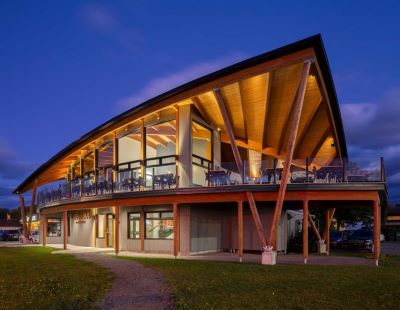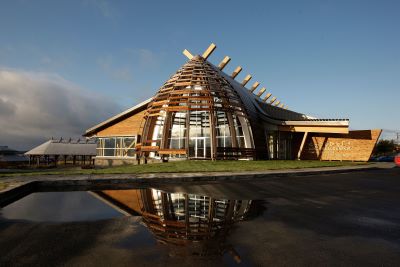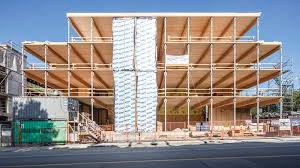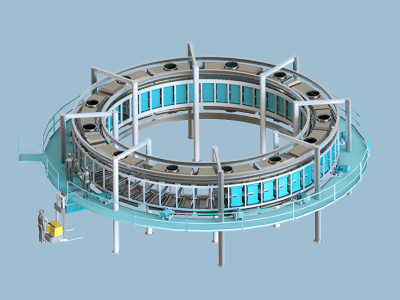Canada needs to create an integrated forest-to-buildings value chain and grow the market for mass timber
 Canada needs a public-private coordination body to develop and advance policies that add value to the country’s forest resources – including increasing the market for mass timber products, says a report by the Transition Accelerator.
Canada needs a public-private coordination body to develop and advance policies that add value to the country’s forest resources – including increasing the market for mass timber products, says a report by the Transition Accelerator.
The “roadmap” report proposes to increase the country’s mass timber market to $1.2 billion by 2030 and double that to $2.4 billion by 2035. The target is that Canada’s mass timber sector serves 25 percent of the global mass timber market. (Photo at right shows a mass timber building in Quebec).
To achieve this target, Canada needs to create an efficient, integrated forest-to-buildings value chain, the report says. “Canada needs to treat its forests as a national resource that can add value to the economy, rather than a commodity-based, volume-driven approach.”
Also required, the report says, is a forest innovation strategy, a national training program for skilled mass timber workers, and a national task force to accelerate Canadian wood solutions for Canada’s housing crisis.
“The federal government and relevant provincial governments should treat the mass timber roadmap process as a strategic priority initiative,” the report says.
“The opportunities for mass timber to contribute to decarbonizing the building sector, generating growth in clean competitiveness sectors, and addressing unmet demand for housing are evident.”
The report, The Mass Timber Roadmap: An integrated forest-to-buildings value chain, was produced in partnership with the Forest Products Association of Canada, the Canadian Wood Council, and Energy Futures Lab.
 The lead co-authors are with the Transition Accelerator: Dr. Bentley Allan, PhD, (photo at right) transition pathway principal, and Dr. Derek Eaton, PhD, (photo at left) director of future economy.
The lead co-authors are with the Transition Accelerator: Dr. Bentley Allan, PhD, (photo at right) transition pathway principal, and Dr. Derek Eaton, PhD, (photo at left) director of future economy.
 Producing the roadmap involved a series of consultations and workshops, complemented by targeted analysis.
Producing the roadmap involved a series of consultations and workshops, complemented by targeted analysis.
Mass timber includes glulam (glue laminated posts and beams), cross laminated timber, and CLT (multi-ply panels of boards laid in crosswise layers), as well as nail and dowel laminated timber.
More than 600 mass timber buildings have been completed in Canada, with 124 projects under construction or in planning stages, according to the report. “Canada has excellent wood resources and expertise all along the supply chain.”
Demand for mass timber beams, panels and buildings is strong and growing, the report says. “The industry is advancing rapidly, but there is work to do to realize this opportunity of increasing manufacturing value-added products to the forest sector.”
Currently, nascent clusters of mass timber manufacturing plants are found in lower mainland B.C., southern interior B.C., and southern Ontario.
Two mass timber companies, B.C.-based Kalesnikoff and Montreal-based Nordic Structures, developed from mills into mass timber production.
Kalesnikoff started as a small mill looking to add value to its products. Nordic is owned by the family that operates Chantiers Chibougamau, a mill with a long history of value-added wood products.
Another company, Western Archrib in Edmonton, has vertically integrated up the supply chain for spruce pine glulam production.
However, Canada is currently falling behind other countries that are using industrial policies to position their firms in rapidly forming global value chains, including for mass timber and other value-added forest products, the report notes.
Central Europe (including Austria, Germany, Italy, Switzerland and Czechia) manufacturers produced about 1.3 million cubic metres of cross-laminated timber in 2022, an increase of almost 20 percent over 2021. Elsewhere in Europe, two large CLT plants were added in Sweden, and one was added in New Zealand.
Denmark has instituted the world’s first national embodied carbon regulation – with a phased-in cap on the carbon footprint of buildings – as part of its national strategy for sustainable construction. Embodied carbon refers to all the greenhouse gas emissions associated with creating building materials, including manufacturing, transportation, installation, maintenance and disposal.
The global mass timber market (as of 2023) is estimated to be between $1.6 billion to $2.3 billion, with the Canadian share of that estimated at $379 million – or about 20 percent.
“Canada needs a systematic analysis of the innovation opportunities along the whole supply chain that is supported by R&D funds,” the report says.
“Innovation along the whole supply chain is needed to create a world-leading mass timber industry that can export into other jurisdictions.”
Mass timber offers multiple benefits
Mass timber is a unique opportunity, according to the report, because it can help meet three critical needs in Canada:
- support the drive to net-zero buildings.
- help address the housing crisis.
- create good jobs in rural and Indigenous communities.
Mass timber provides an opportunity to combine economic reconciliation and sustainable resource management objectives, the report says.
 In some places, there is strong interest from First Nations to build with mass timber in construction. Existing examples of mass timber buildings in Indigenous communities include Squamish Lil’wat Cultural Centre, the Nadleh Whut’enne Yah Administration and Cultural Building, and the Aanischaaukamikw (Cree Cultural Institute (photo at right), to name just a few.
In some places, there is strong interest from First Nations to build with mass timber in construction. Existing examples of mass timber buildings in Indigenous communities include Squamish Lil’wat Cultural Centre, the Nadleh Whut’enne Yah Administration and Cultural Building, and the Aanischaaukamikw (Cree Cultural Institute (photo at right), to name just a few.
Mass timber helps to reduce the carbon intensity of construction by eliminating concrete and steel emissions and by providing long-term carbon storage.
Using wood products alongside other cost-effective decisions can reduce embodied carbon by as much as 40 percent, according to the report. Since embodied carbon in materials represents the majority of lifecycle emissions from the construction of buildings, “mass timber can have a huge impact.”
Mass timber made its name in “tall wood” buildings and showpiece non-residential buildings. Many of these buildings were one-off designs.
 But now, the report points out, mass timber is primed to become a mainstream material of choice in residential applications, especially the four-to-six storey range and more common seven-to-12 storey buildings, including hybrid structures that combine wood with steel and concrete.
But now, the report points out, mass timber is primed to become a mainstream material of choice in residential applications, especially the four-to-six storey range and more common seven-to-12 storey buildings, including hybrid structures that combine wood with steel and concrete.
FP Innovations has estimated that approximately 100,000 cubic metres of mass timber were used in construction in 2022. Estimated current production across Canada is between 200,000 to 300,000 cubic metres.
The report’s target is to utilize mass timber products in five percent of all construction materials, including in 25 percent of all multifamily residential structures and nonresidential buildings, making use of significant modular or prefabricated elements.
In helping to address Canada’s housing crisis, mass timber designs – especially those incorporating prefabrication and modular approaches – offer a promising strategy to accelerate the construction of multi-unit residential structures, at greater speeds and lower costs, the report says.
Mass timber panels, particularly cross-laminated timber, create opportunities for prefabrication because they allow entire wall assemblies to be manufactured and customized offsite. Window and door openings can be pre-cut and standardized connections can be used to assemble components quickly. “These elements of prefabrication can be used to create highly customizable buildings.”
Mass timber can shorten construction times by as much as 20 percent, the report notes. This lowers constructions costs (and financing costs), which are a major part of a building’s lifetime cost. Prefabrication and modularization could drive costs even lower.
Workstreams and goals for the mass timber roadmap
To coordinate and clarify more specific actions, the report divides the timber ecosystem into five workstreams, each with its own specific near-term goal:
- Forestry and wood supply: Advance mass timber specific milling and drying needs while scoping out the transformative changes to harvesting and timber grading that would be needed to create an integrated mass timber supply chain.
- Manufacturing: Increase production capacity, including pre-manufacturing of lamina and billets and prefabrication.
Expansion of existing facilities, and the construction of new, larger integrated facilities, is needed to bring down unit costs and drive demand beyond one-off showpiece buildings and into the mainstream market. Supply-side policies need to support manufacturers in securing financing to expand and construct facilities.
- Architecture, building codes, design and fire safety: Identify strategic niches for pre-fabricated connections and secure low-hanging fruit changes in building codes.
- Construction: Drive the uptake of mass timber as mainstream material in construction, and expand beyond one-off buildings into repeatable forms, large building markets and hybrid construction.
- Policy, programs and sustainability: Develop a policy package – with measures such as grants, tax incentives, R&D programs and life cycle analysis synthesis – that would help the industry scale up while building homegrown capacity along the supply chains.
To scale, mass timber needs the right incentives to overcome a chicken-and-egg situation in the value chain, the report says. Manufacturers need to see market demand to justify large capital investments, and building designers and developers need to have assurance of timely supply of mass timber products.
There are several reasons to follow a regionalized approach in scaling mass timber production, according to the report.
One reason is transport costs and associated carbon footprints. Scaling of the Canadian and North American markets for mass timber needs solutions to the longer transportation distances to relevant markets, compared with Europe.
A second factor is the existing imbalance between the location of production capacity and demand. The strongest demand prospects in Canada for mass timber are in the fastest-growing construction market of Ontario, also offering prospects for neighbouring provinces.
Highest-priority actions in three critical areas
The report says the highest priority actions in the three critical action areas should be:
- Create a public-private collaboration to develop and advance a policy package:
- Create a public-private coordination body to develop and advance policy and program priorities.
- Create a government plan to deploy strategic finance.
- Explore an embodied carbon requirement as part of the Green Building Strategy.
- Make changes to building and fire code to enable further market penetration. Remove “combustible” language from building and fire codes and replace with a performance-based standard. This will put wood on a level-playing field with other materials.
- Adjust the Greening Government Strategy to help mass timber scale through procurement.
- Develop a forest sector innovation strategy.
- Standardize building archetypes, wood specifications and connectors (similar to what the steel industry has) across the whole supply chain:
- Develop a standardized product suite for lumber (size, grade, moisture). Mass timber has specific needs for drying and milling. Achieving the scale necessary for mass timber-specific milling is the real challenge for wood supply.
- Develop priority standardized products for main growth segments.
- Develop standard connector opportunities.
- Develop affordable and practical systems for building archetypes.
- Identify niche high-value building elements that could be used as test cases to bring prefabrication down the cost-curve.
- Develop and implement a skills development plan that covers all aspects of the supply chain:
- Assess skills needs and develop appropriate and targeted training programs.
Additional structural wood courses in universities need to be developed, building on the University of British Columbia’s lead, and the education roadmap program developed by the Canadian Wood Council, including the woodSMART resource, the report says.
The BC Institute of Technology is investing $3.3 million in a mass timber skills hub. However, the institute only has capacity for about 16 students every six months.
- Education for architects, engineers, financing and development teams.
- Develop a national training program for skilled mass timber workers.
- Develop regional educational hubs.
Role for industry, government and other stakeholders
The mass timber roadmap now needs to be advanced by an alliance of industry and other stakeholders, working closely with government, the report says.
It says a coordinating council should oversee implementation of the roadmap, supported by individual taskforces for each of the five respective workstreams.
Governments need to be active participants in the process, as members of the council and taskforces, the report says.
There is an important role for government in providing catalytic investments and creating demand certainty, including through a strong government procurement program, the report adds. “Canada’s mass timber industry is a strong candidate for strategic investment through the Canada Growth Fund,” as well as the Canada Infrastructure Bank.
British Columbia, for example, has a Mass Timber Action Plan. On the demand side, there is the use of mass timber in public-sector buildings and Vancouver’s proposed embodied carbon regulations. These both encourage the use of mass timber, although a systematic policy to incentivize low-carbon materials at the provincial level would be even more powerful.
On the supply side, B.C. has created a $180-million fund to add manufacturing value in the province, with a focus on the forestry sector. Mass timber projects are eligible for up to $10 million in capital support.
Canada’s current mass timber production accounts for not even one percent of Canada’s wood supply (softwood and hardwood), and only one to two percent of North America’s softwood lumber production (as of 2021), according to the report.
“The long-term economic goal should be to use mass timber, as one of a range of net-zero aligned opportunities, as a way to add value to Canada’s primary forest production before export.”
Canada has a significant opportunity to scale the mass timber sector in response to significant market demand, both domestically and internationally, the report says. This will generate regional economic development opportunities, including skilled jobs.
“Seizing this opportunity requires an intentional and concentrated effort now of businesses and other actors throughout the ecosystem.”
R$
Events For Leaders in
Science, Tech, Innovation, and Policy
Discuss and learn from those in the know at our virtual and in-person events.
See Upcoming Events
You have 0 free articles remaining.
Don't miss out - start your free trial today.
Start your FREE trial Already a member? Log in
By using this website, you agree to our use of cookies. We use cookies to provide you with a great experience and to help our website run effectively in accordance with our Privacy Policy and Terms of Service.





.png)